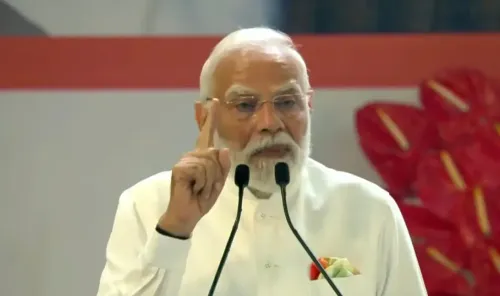Slight Temperature Drop in Gujarat, Humid Heat Continues in Coastal Areas

Synopsis
Key Takeaways
- Ahmedabad sees a temperature drop to 39.7°C.
- Coastal districts remain under hot and humid conditions.
- Rajkot reports the highest temperature at 41.7°C.
- No heatwave warning issued by IMD for the coming week.
- Gujarat government implements Heat Action Plan.
Ahmedabad, April 21 (NationPress) - A slight decrease in maximum temperatures was noted in Ahmedabad and various regions of Gujarat on Sunday, bringing a welcome break after several days of intense summer heat. Nevertheless, hot and humid conditions are set to continue in coastal districts like Surat, Diu, Daman, and Veraval on April 22, 23, and 24.
After remaining above 40 degrees Celsius for more than a week, the maximum temperature in Ahmedabad dropped to 39.7 degrees Celsius, indicating a slight decline.
Despite this temporary relief, regions continued to experience heat, with Rajkot recording the highest temperature at 41.7 degrees Celsius, which is 2.0 degrees Celsius above normal.
Other areas with temperatures exceeding 40 degrees Celsius included Amreli (40.9 degrees Celsius), Surendranagar (40.8 degrees Celsius), and both Bhuj and Gandhinagar (40.2 degrees Celsius).
Only these locations in Gujarat saw daytime temperatures surpassing the 40 degrees Celsius mark on Sunday.
Conversely, Baroda reported a slightly lower maximum of 38.5 degrees Celsius, while coastal areas remained cooler due to the sea breeze and elevated humidity.
Surat hit a maximum of 34.6 degrees Celsius, with Dwarka and Veraval recording temperatures of 31.1 degrees Celsius and 32.0 degrees Celsius respectively.
Humidity in coastal cities like Daman and Bhavnagar was notably higher, contributing to muggy conditions.
The latest bulletin from the Indian Meteorological Department (IMD) states that no heatwave warning has been issued for the upcoming week.
However, persistent hot and humid weather is anticipated in coastal districts such as Surat, Diu, Daman, and Veraval on April 22, 23, and 24.
Sunday's weather report from the IMD indicates a minimum temperature of 25.7 degrees Celsius in Ahmedabad, with relative humidity recorded at 61 percent at 8:30 a.m., which decreased to 17 percent by evening.
No rainfall was observed across the state. With maximum temperatures in several regions still hovering near or exceeding normal levels, weather experts recommend taking precautions against heat exposure, particularly in interior and western districts.
In response to the severe summer heat, the Gujarat government has implemented a range of proactive measures aimed at protecting public health and ensuring uninterrupted essential services.
Under the Heat Action Plan, formulated in collaboration with the Indian Meteorological Department and health agencies, local authorities have been instructed to monitor vulnerable populations such as children, the elderly, and outdoor workers.
Healthcare facilities throughout the state have been equipped to handle heatstroke cases, while awareness campaigns are underway to inform citizens about preventive measures, hydration, and early signs of heat-related illnesses.
Municipal corporations and local bodies have been directed to guarantee a consistent water supply, especially in heat-sensitive areas, and to maintain community water tanks, public drinking water points, and cooling shelters.
In cities like Ahmedabad, temporary shades and cooling stations have been established at traffic intersections and bus stops.
The education department has modified school timings in certain districts to protect children from peak afternoon heat.
Additionally, the power department is closely monitoring electricity demand to prevent outages during periods of high consumption caused by widespread use of cooling devices.









